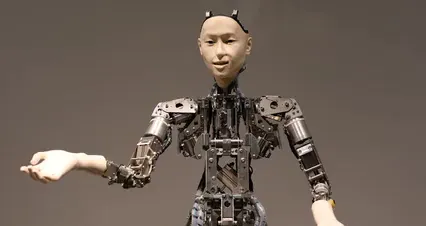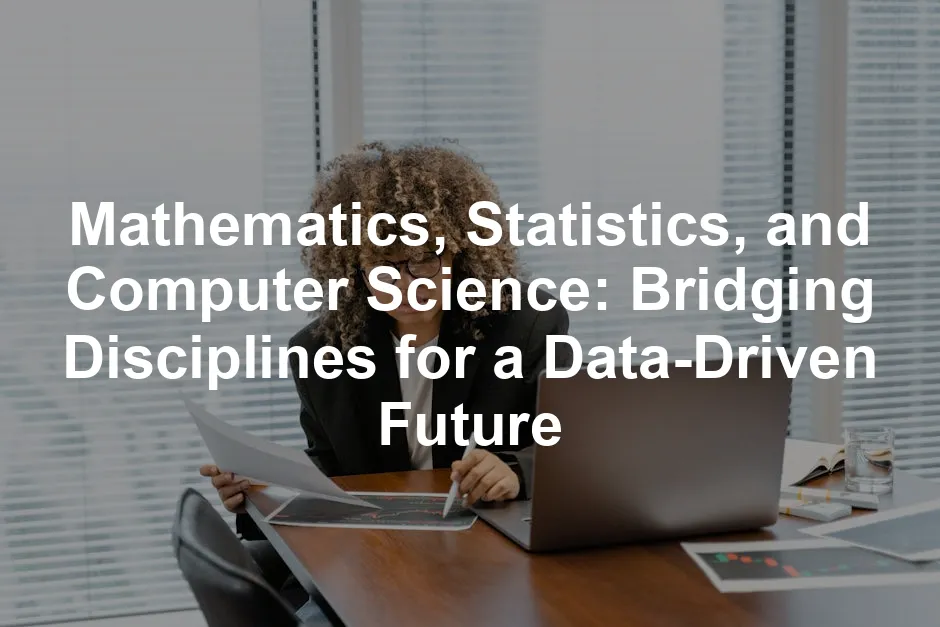Introduction
Mathematics, statistics, and computer science are like the three musketeers of the modern academic world. They each have their own strengths but work together seamlessly to tackle today’s data-driven challenges. Mathematics lays the groundwork with its logical principles and numerical theories. Statistics steps in to interpret data, turning raw numbers into meaningful insights. Computer science, the tech-savvy genius, utilizes both to develop algorithms and software that drive innovation across various sectors.
The significance of these disciplines can’t be overstated. In technology, they are the backbone of software development and artificial intelligence. Finance relies heavily on mathematical models and statistical analyses for risk assessment and investment strategies. The healthcare sector employs statistical methods for research and epidemiology, ensuring public health and safety. Education, too, benefits from these fields, enhancing teaching methodologies and learning outcomes.
This article aims to shed light on how mathematics, statistics, and computer science intersect. We’ll explore their applications, real-world relevance, and the exciting career prospects they offer. With the world increasingly leaning toward data-driven decisions, understanding these connections is more critical than ever. So, buckle up as we embark on this enlightening journey through the interconnected universe of numbers, data, and algorithms!

The Foundations of Each Discipline
Mathematics
Mathematics is the study of numbers, shapes, and patterns. It serves as a universal language that expresses ideas and relationships clearly. Key areas of mathematics include algebra, calculus, and discrete mathematics. Algebra deals with symbols and the rules for manipulating them, while calculus focuses on change and motion. Discrete mathematics, on the other hand, studies structures that are fundamentally discrete rather than continuous.
These areas of mathematics are not just academic; they are highly applicable. For instance, algebra and calculus form the basis for algorithms used in computer science. Algorithms are step-by-step procedures for calculations, essential for programming and data analysis. Mathematics also plays a pivotal role in statistical modeling, where it helps in formulating models to predict outcomes based on given data.
In a world increasingly driven by technology, strong mathematical foundations are indispensable. They equip individuals with the analytical skills needed to solve complex problems, whether in engineering, physics, economics, or data science. Thus, mathematics isn’t just a subject; it’s a critical tool that opens doors to various opportunities across multiple fields. To dive deeper into mathematical concepts, check out Mathematics for Machine Learning. It’s a great resource for anyone looking to sharpen their skills!
In summary, mathematics, statistics, and computer science are intricately linked. Each discipline enhances the others, creating a robust framework for understanding and manipulating data. Understanding these connections can lead to innovative solutions and career pathways that shape the future.

Statistics
Definition and Importance
Statistics is the science of data collection, analysis, interpretation, and presentation. It transforms raw data into actionable insights. Without statistics, we’d be lost in a sea of numbers, like a sailor without a compass! It helps us make informed decisions in our daily lives and various industries. From predicting weather patterns to analyzing election results, statistics plays a pivotal role. For an in-depth look at key resources, check out the AP Statistics Formula Sheet.
Understanding statistics is crucial for interpreting data effectively. Explore the AP Statistics Formula Sheet for essential insights.
Key Concepts
Three fundamental concepts in statistics stand out: descriptive statistics, inferential statistics, and probability. Descriptive statistics summarize data sets, providing quick snapshots of trends. Think of it as the highlight reel of a sports game! Inferential statistics, however, takes it a step further. It allows us to make predictions and generalizations about a population based on sample data. Lastly, probability measures the likelihood of an event occurring. It’s like rolling dice; you can calculate your chances of winning!
Real-World Applications
Statistics finds applications across various fields. In public health, it helps track disease outbreaks and evaluate treatment effectiveness. Ever wondered how vaccines are tested? Statistics is key! In economics, it aids in understanding market trends and consumer behavior. Social sciences utilize statistics to analyze survey results and study human behavior. Whether you’re in a lab or a boardroom, statistics is your trusty sidekick. To get a comprehensive overview of statistical methods, consider Statistics for Data Science by James D. Miller.

Computer Science
Definition and Evolution
Computer science is the study of computational systems and their applications. It has evolved from theoretical foundations to practical applications that drive our technology-laden lives. What started as a quest to understand algorithms has grown into a vast field encompassing everything from software development to cybersecurity. Think of it as the magic behind your favorite apps and devices!
Core Areas
Key areas in computer science include programming, data structures, algorithms, artificial intelligence, and machine learning. Programming is the language of computers, enabling us to create software. Data structures organize information efficiently, while algorithms solve problems step-by-step. Artificial intelligence and machine learning are the stars of the show, driving innovations from self-driving cars to virtual assistants. These areas work together, creating a powerful toolkit for tech enthusiasts. For a comprehensive understanding of how statistics integrates with computer science, visit Statistics for Computer Science.
Computer science relies heavily on statistical methods for data analysis. Learn more about the integration of statistics in computer science.
Role in Data Analysis
Computer science significantly supports statistical methods and mathematical modeling. It provides the tools necessary for processing and analyzing large datasets. When statistics meets computer science, the result is data analysis that can unlock insights faster than you can say “data-driven decisions.” Together, they empower businesses and researchers to make informed choices based on solid evidence. If you’re interested in delving deeper, check out Python for Data Analysis by Wes McKinney.

The Interdisciplinary Approach
Integration of Disciplines
Why Interdisciplinary Knowledge is Essential
In today’s fast-paced world, knowledge knows no bounds. The complex problems we face demand a blend of skills from various disciplines. A multidisciplinary approach allows us to tackle real-world challenges with innovative solutions. Whether it’s combating climate change or analyzing big data, combining mathematics, statistics, and computer science creates a powerhouse of problem-solving potential.
Consider data science, for instance. This field thrives on mathematical models, statistical analysis, and computer algorithms. By integrating these disciplines, data scientists can extract meaningful insights from vast datasets. The interplay of these fields leads to better decision-making across industries. From healthcare to finance, interdisciplinary knowledge is the glue that holds effective solutions together. To further explore the field, check out The Data Science Handbook by Carl Shan.

Examples of Interdisciplinary Fields
Several fields exemplify the beauty of integrating mathematics, statistics, and computer science. Data science tops the list, where experts use statistical techniques and computational tools to analyze data. Bioinformatics is another prime example, merging biology with statistics and computer science to decode genetic information. Computational finance takes this integration further, applying mathematical models and statistical methods to optimize investment strategies.
These disciplines also intersect in artificial intelligence (AI). AI relies on statistical learning and mathematical modeling for algorithm development. Machine learning, a subset of AI, exemplifies this blend, where algorithms learn from data patterns to make predictions. The result? Smarter technology that can revolutionize industries! For a deeper dive into AI, consider Artificial Intelligence: A Modern Approach by Stuart Russell.

Educational Pathways
Degree Programs
For students eager to dive into these interdisciplinary fields, numerous academic programs exist. Many universities offer joint degrees that combine mathematics, statistics, and computer science. For instance, a Bachelor of Science in Statistics and Computer Science equips students with essential skills across both areas. Similarly, a Mathematics and Computer Science degree provides a well-rounded foundation for future careers in tech.
These programs not only focus on theoretical knowledge but also emphasize practical applications. Hands-on projects and collaborative coursework prepare students for the workforce. Institutions are increasingly adopting project-based curricula, allowing students to engage in real-world problems. This approach fosters teamwork, encourages creativity, and enhances critical thinking skills. For those interested in a solid statistical foundation, look into Statistics in Plain English by Timothy C. Urdan.

Skills Development
Studying these interconnected disciplines cultivates a toolbox of critical skills. Analytical thinking becomes second nature as students learn to interpret data and solve complex problems. Problem-solving skills are honed through practical applications, enabling students to tackle challenges head-on. Quantitative reasoning, another vital skill, equips students to analyze numerical data effectively.
Moreover, communication skills flourish in interdisciplinary settings. Explaining complex concepts to non-experts is essential in today’s collaborative environment. Students learn to present data insights in a clear and compelling manner, making them invaluable in any workplace.
The importance of interdisciplinary education is evident. As industries evolve, the demand for graduates with a blend of skills continues to rise. Employers seek individuals who can bridge gaps between disciplines and drive innovation. By pursuing interdisciplinary studies, students position themselves at the forefront of the data-driven future, ready to make a meaningful impact.

Career Opportunities
Overview of Career Options
The demand for professionals skilled in mathematics, statistics, and computer science is soaring! Companies are on the lookout for individuals who can crunch numbers, analyze data, and develop software solutions. As organizations continue to rely on data-driven decision-making, the need for specialists in these fields is more pronounced than ever. In fact, industries ranging from finance to healthcare are racing to fill these roles.
A report from the U.S. Bureau of Labor Statistics projects that jobs in computer science and mathematics will grow by 22% from 2020 to 2030, significantly faster than the average for all occupations. This growth isn’t just a trend; it’s a fundamental shift in how businesses operate. As technology advances and data becomes increasingly valuable, the importance of these skill sets will only grow.

Specific Careers
Data Scientist
Data scientists are the rock stars of the analytics world! They sift through vast amounts of data to discover patterns and insights that drive business strategies. Their responsibilities include cleaning data, developing algorithms, and visualizing results. A successful data scientist needs proficiency in programming languages like Python and R, along with a solid understanding of statistics and machine learning. Creativity and critical thinking are essential in turning raw data into actionable insights. For practical guidance on statistics for data scientists, refer to Practical Statistics for Data Scientists PDF.
Data scientists require a strong foundation in statistics and programming. Check out the Practical Statistics for Data Scientists guide for insights.

Statistician
Statisticians play a crucial role in various industries by designing surveys and experiments to collect data. They analyze this data to make predictions or inform decisions. Statisticians are not just number crunchers; they are storytellers who communicate complex findings in a digestible manner. They work in fields like public health, finance, and government. To excel, one should be well-versed in statistical software and possess strong analytical skills. For those interested in a comprehensive understanding of statistics, consider exploring Statistics for Nonstatisticians by Wissing.
Statisticians need to communicate their findings effectively. Learn more about the guide for non-statisticians.

Software Engineer
Software engineers are the architects who build the applications and systems we use daily. Mathematics is the backbone of their work, aiding in algorithm design and problem-solving. They need a deep understanding of programming languages such as Java, C++, or JavaScript. Additionally, a firm grasp of data structures and discrete mathematics is essential for optimizing code and ensuring efficient performance. The demand for skilled software engineers is relentless, with companies eager to innovate and improve their technology. For those who want to master programming, a great starting point is The Pragmatic Programmer by Andrew Hunt.

Actuary
Actuaries are the unsung heroes of risk management. They use mathematical and statistical methods to evaluate risks and uncertainties in various industries, primarily insurance and finance. Actuaries analyze data to forecast future events and help companies make informed decisions. The path to becoming an actuary typically requires passing a series of rigorous exams, but the rewards are substantial. Actuaries enjoy high salaries and job security, making it a sought-after career choice. For those looking to prepare for actuarial exams, consider Mathematical Puzzles: A Connoisseur’s Collection by Peter Winkler.

Emerging Fields
Artificial Intelligence
Artificial Intelligence (AI) is revolutionizing industries! Mathematics and statistics are the backbone of AI development. Machine learning algorithms rely on statistical models to learn from data, improving their accuracy over time. Careers in AI include machine learning engineers, AI researchers, and data analysts. These roles are not just about programming; they require a strong foundation in mathematical concepts like linear algebra and calculus. For a solid introduction to the field, check out Deep Learning by Ian Goodfellow.

Big Data
Big data analytics is another booming field! Organizations generate massive amounts of data daily, and they need skilled professionals to make sense of it. Careers in big data analytics include data engineers and data analysts. These experts design systems to store and process data efficiently and develop algorithms to analyze it. The skills required often overlap with those needed in statistics and computer science, making this an exciting area for interdisciplinary professionals. To get a head start in data mining, consider Data Mining: Concepts and Techniques by Jiawei Han.

In conclusion, the intersection of mathematics, statistics, and computer science provides a wealth of career opportunities. With the right skills and knowledge, you could find yourself in a dynamic and rewarding profession that shapes the future of various industries. So, whether you’re eyeing a role as a data scientist or an actuary, the possibilities are endless!
Challenges and Opportunities in Mathematics, Statistics, and Computer Science
Challenges
Skill Gaps
The education landscape in mathematics, statistics, and computer science faces significant skill gaps. Many students are not adequately prepared for the workforce. Traditional teaching methods often focus on theory over practical application. This creates a disconnect between what students learn and the skills employers seek. Additionally, the rapid pace of technological advancement means that curricula struggle to keep up. Many graduates find themselves lacking essential coding skills or analytical thinking capabilities. This gap not only affects individual careers but also hampers industry growth, as companies struggle to find qualified professionals.
Access and Equity
Access and equity remain pressing issues in these fields. The lack of diversity in mathematics, statistics, and computer science is noticeable. Underrepresented groups often face systemic barriers that discourage participation. For instance, students from low-income backgrounds may not have access to advanced coursework or resources like tutoring. This inequity perpetuates a cycle where only a select group can thrive in these disciplines. Moreover, the inclusion of diverse perspectives is crucial. A homogenous workforce may overlook innovative solutions and creative problem-solving approaches that come from varied experiences and backgrounds.
Opportunities
Technological Advancements
Amidst the challenges, the rise of new technologies presents exciting opportunities. Fields like artificial intelligence (AI), machine learning, and cloud computing are booming. These advancements require a solid grounding in mathematics and statistics. Job roles in data science, machine learning engineering, and AI research are increasingly in demand. Professionals who can leverage these technologies to analyze data and derive actionable insights will find themselves at the forefront of innovation. As organizations invest in data-driven decision-making, the intersection of these fields will play a pivotal role in shaping future technological landscapes. To explore the theoretical side, consider Introduction to the Theory of Computation by Michael Sipser.
Collaborative Research
Collaborative research across disciplines is another avenue of opportunity. Mathematics, statistics, and computer science intersect in areas like bioinformatics, computational finance, and social data analytics. Projects that integrate these fields often yield groundbreaking results. For instance, combining statistical models with computational algorithms can lead to discoveries in healthcare, climate science, and economics. Universities and research institutions are increasingly promoting interdisciplinary initiatives. Such collaboration not only enriches academic research but also prepares students for the complexities of real-world challenges, fostering a new generation of problem solvers.
Conclusion
In summary, the integration of mathematics, statistics, and computer science is crucial in today’s data-driven society. Each discipline reinforces the others, creating a comprehensive framework for understanding and leveraging data. However, challenges like skill gaps and equity issues must be addressed to unlock the full potential of these fields.
Looking ahead, the future of mathematics, statistics, and computer science is bright yet demanding. As technology continues to advance, professionals in these areas will be at the heart of innovation. The growth of AI, big data, and analytics will require a workforce that is not only skilled but also adaptable.
To harness these opportunities, we encourage students to consider interdisciplinary studies. By merging knowledge from these fields, they can cultivate a diverse skill set that enhances employability and adaptability in a rapidly changing job market. The path to innovation and development lies in embracing the interconnectedness of mathematics, statistics, and computer science. Let’s champion diversity and equity in these fields, ensuring that everyone has the chance to contribute to this exciting future.
FAQs
What is the difference between statistics and mathematics?
Statistics focuses on data collection, analysis, and interpretation. Mathematics is broader, encompassing various branches like algebra, calculus, and geometry. While statistics relies heavily on mathematical principles, its primary goal is to draw conclusions from data rather than solve abstract problems.
Can I pursue a career in computer science without a math degree?
Yes, it is possible! However, a solid understanding of math can enhance problem-solving skills in computer science. Many computer science concepts, like algorithms and data structures, have mathematical foundations. It’s beneficial to have at least some math knowledge.
What are the best degrees for a career in data science?
Degrees in data science, statistics, computer science, or mathematics are excellent choices. Programs that offer interdisciplinary approaches, combining these fields, prepare students for the diverse challenges in data analysis and predictive modeling.
How can interdisciplinary studies benefit my career?
Interdisciplinary studies enhance employability by equipping you with diverse skills. Employers value candidates who can approach problems from multiple perspectives. This adaptability is crucial in fields like data science, where knowledge of statistics, programming, and domain expertise is key.
What skills should I develop for a career in these fields?
Key skills include programming, statistical analysis, data visualization, and critical thinking. Familiarity with tools like Python, R, and SQL can be advantageous. Additionally, honing soft skills like communication and teamwork will help you excel in collaborative environments.
Please let us know what you think about our content by leaving a comment down below!
Thank you for reading till here 🙂
All images from Pexels




